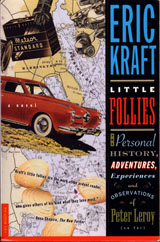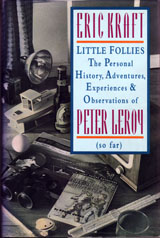

| Little Follies
Do Clams Bite? Preface: On the Memories of Childhood |
by Eric
Kraft, as Peter
Leroy
|

YOU CAN READ THE FIRST HALF
YOU CAN ORDER THE
|
I had been using this little story effectively at dinner tables for quite a few years. Sentimentalists could release a wistful sigh or two for the innocent little Peter in it, and intellectuals could ride the castration theme for a couple of hours. One evening, early in the telling, just after I had introduced Big Grandfather and Big Grandmother, my father’s large and sturdy parents, the realization struck me that over the years, as I had told the story I had distorted the events and characters beyond recognition. It was time, I thought, to strip away the baloney and get down to the truth. The result of my effort to tell it without embellishment, just as it happened, begins in a few pages, but before we get to it I would like to give you an idea of how I went about reconstructing the incident and to point out one or two facts that I may have made up. CONSCIOUSLY TRYING to revisit the past is a little like trying to see
back through a long tunnel or, more accurately, one of those corrugated
metal culverts through which streams are allowed to run under roadways.
Bear with me through this. The culvert itself is the set of your
current prejudices, desires, antipathies, enthusiasms, regrets, and whatnot
that restrict your view of the past. You peer through this narrow
tube and see only a tiny circle of light, though you are certain that there
is more back there at the other end, beyond what you can see. Apparently,
just looking won’t be enough. You are going to have to crawl through
the culvert and see what is back there. If you make it all the way
through, you will be surprised by what you find. You will have the
odd sensation of being in unfamiliar territory and yet recognizing everything.
ANOTHER CHANGE from actual fact was prompted by good taste, rather than by structure or logic or any of the other considerations that ordinarily influence a writer. I have made two of my ancestors, Black Jacques Leroy and his son Fat Hank Leroy, rather tame: two more or less harmless businessmen, whose interests were limited to beer and poetry. I left a lot unsaid, because I knew that if I had dragged in the tales of Black Jacques’s establishing Corinne’s Dockside Bordello, his liaison with his son’s wife, or his role in the Tong Wars between clamming factions, my family would have suffered considerable embarrassment. It was also a question of taste that made me have Fat Hank sell Leroy Lager, although in fact the brewery is still the cornerstone of the tiny Leroy fortune. The stuff has simply become so anemic that it embarrasses me to admit that I’m connected with it. AT HEART, THOUGH, “Do Clams Bite?” is not about events or people.
It is about fear. It is about several boyhood fears: the fear of
saying the wrong thing, fear of sex, fear of oblivion, fear of becoming
like one’s parents, fear of other boys (especially those who carry knives),
and—most of all—the fear of having a hunk of oneself bitten off by a clam.
As a boy, I suffered this fear in silence. Only later did I learn
that I had not been the only sufferer. Although this fear was not
widespread, many boys in Babbington did suffer from it: that group of boys
whose fathers or grandfathers were casual clam-diggers, who went right
into the water after the clams, feeling for them with their feet, who wore
brief woolen bathing suits and stored the clams they caught in the fronts
of their suits.
Peter Leroy
|
 |
||||
| ..... | .......... | .......... | ..... |

Here are a couple of swell ideas from Eric Kraft's vivacious publicist, Candi Lee Manning: Tip the author.
Add yourself to our e-mailing list.
|
Little Follies is a work of fiction. The characters, incidents, dialogues, settings, and businesses portrayed in it are products of the author’s imagination and are not to be construed as real. Any resemblance to actual events or persons, living or dead, is entirely coincidental. All rights reserved. No part of this book may be reproduced or transmitted in any form or by any means, electronic or mechanical, including photocopying, recording, or by any information storage and retrieval system, without permission in writing from the author. “My Mother Takes a Tumble,” “Do Clams Bite?,” “Life on the Bolotomy,” “The Static of the Spheres,” “The Fox and the Clam,” “The Girl with the White Fur Muff,” “Take the Long Way Home,” and “Call Me Larry” were originally published in paperback by Apple-Wood Books. Little Follies was first published in hardcover by Crown Publishers, Inc., 201 East 50th Street, New York, New York 10022. Member of the Crown Publishing Group. YOU CAN ORDER THE
For information about publication rights outside the U. S. A., audio rights, serial rights, screen rights, and so on, e-mail the author’s imaginary agent, Alec “Nick” Rafter. The illustration at the top of the page is an adaptation of an illustration by Stewart Rouse that first appeared on the cover of the August 1931 issue of Modern Mechanics and Inventions. The boy at the controls of the aerocycle doesn’t particularly resemble Peter Leroy—except, perhaps, for the smile. |
ABOUT
THE PERSONAL HISTORY
LITTLE
FOLLIES
|
||||||
| . | . |